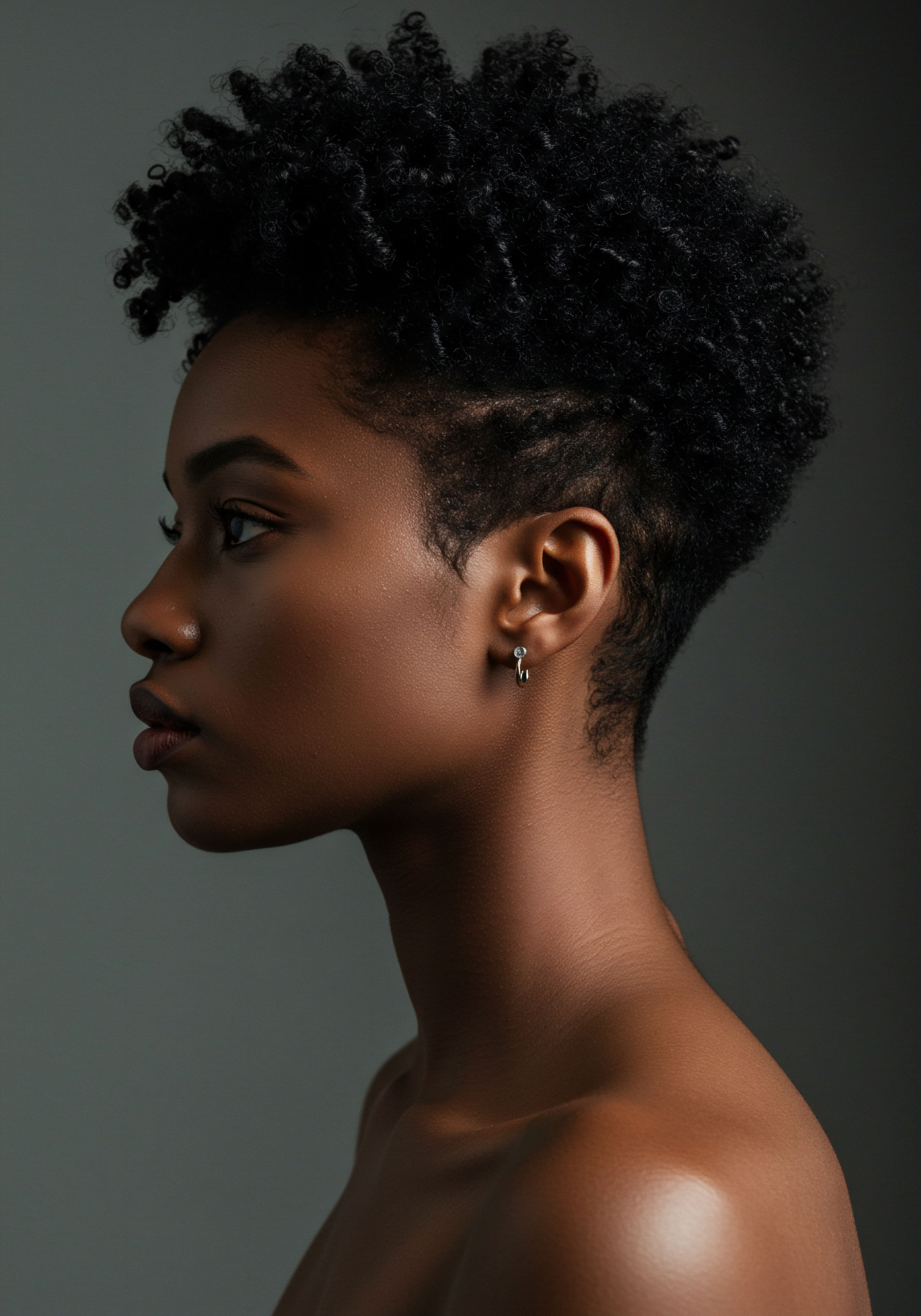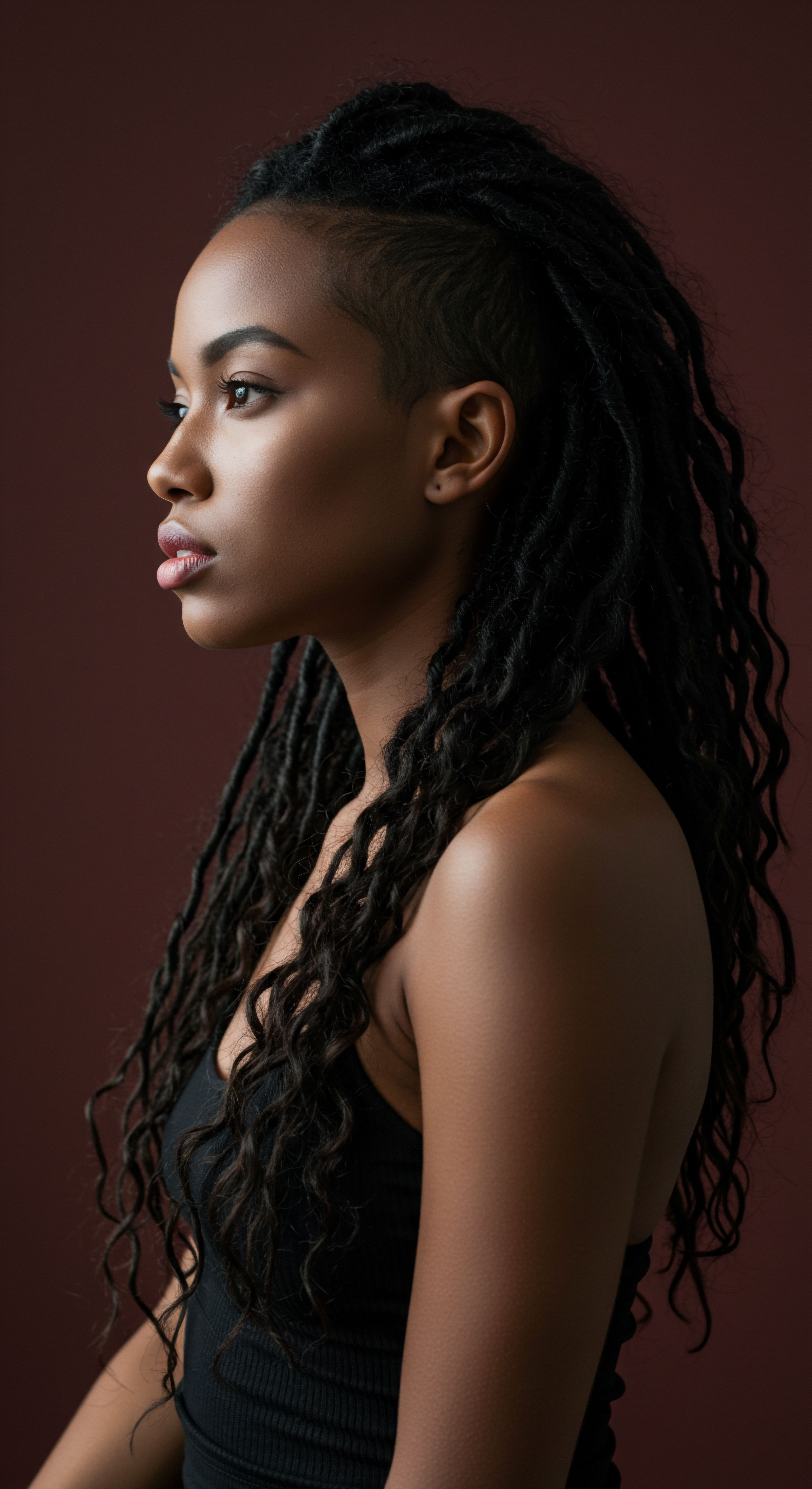
Roots
Have you ever observed the quiet changes in your hair, perhaps a subtle shift in its resilience or vibrancy, that seemed to mirror the restless nights you endured? The connection between our inner rhythms and the outward expression of our being, particularly our textured strands, is a deep, often unspoken truth. Our hair, a living extension of us, whispers tales of our overall wellness, and its very foundation, the follicle, draws sustenance from the body’s delicate balance. To truly appreciate the journey of a single strand, from its hidden beginnings to its visible crown, requires a thoughtful consideration of the biological underpinnings that govern its existence.
Hair growth, a continuous cycle of creation and renewal, begins deep within the skin. Each hair strand originates from a tiny, specialized organ known as the hair follicle. These microscopic structures are far more than mere anchors; they are dynamic mini-organs, tirelessly working to produce the protein filaments we recognize as hair.
Within the follicle, dermal papilla cells play a critical role, sending signals to the surrounding matrix cells, which then divide and differentiate to form the hair shaft. This intricate cellular dance is highly sensitive to the body’s internal environment, making it susceptible to disruptions from various systemic factors.
The health of each hair strand is intrinsically linked to the delicate biological dance occurring within its foundational follicle.

Understanding Hair Follicle Physiology
The follicle itself is a marvel of biological engineering. It consists of several distinct layers, each with a specific function. The outer root sheath surrounds the hair shaft, while the inner root sheath guides the growing hair. At the base lies the hair bulb, containing the dermal papilla and the hair matrix.
The dermal papilla, rich in blood vessels and nerve endings, delivers nutrients and oxygen essential for cell division. The hair matrix, a region of rapidly dividing cells, produces the keratinocytes that form the hair shaft. This rapid cellular turnover means the follicle has a high metabolic demand, requiring a consistent supply of energy and building blocks.
The activity of hair follicles is not constant; they operate in distinct phases. This cyclical nature is a fascinating aspect of hair biology, dictating periods of active growth, transition, and rest.
- Anagen The growth phase, lasting from two to seven years for scalp hair. During this period, cells in the hair matrix divide rapidly, pushing the hair shaft upward and outward.
- Catagen A brief transitional phase, lasting about two to three weeks. Hair growth ceases, and the follicle shrinks.
- Telogen The resting phase, lasting around two to four months. The old hair strand remains in the follicle but is not actively growing. At the end of this phase, the old hair sheds, and a new anagen phase begins.
Any interference with these finely tuned cycles can lead to changes in hair density, texture, or growth rate. Stress, nutritional deficiencies, hormonal imbalances, and even environmental exposures can all play a part in altering this natural rhythm. Our focus here, however, turns to the silent architect of our physiological restoration ❉ sleep.

How Circadian Rhythms Govern Cellular Renewal
The human body operates on a roughly 24-hour cycle known as the circadian rhythm, influencing countless biological processes, including cell regeneration, hormone secretion, and metabolic activity. These rhythms are regulated by the body’s internal clock, primarily located in the brain’s suprachiasmatic nucleus. Light and darkness are powerful cues for this internal clock, synchronizing our bodily functions with the external world.
During periods of restful slumber, the body enters a state of profound repair and rejuvenation. Cellular division, protein synthesis, and tissue regeneration are often heightened during specific sleep stages. This includes the cells within our hair follicles. Disruptions to this natural rhythm, whether from irregular sleep patterns, insufficient duration, or poor quality, can send ripples through the body’s intricate systems, potentially impacting the very processes that keep our hair strong and vibrant.
| Biological Process Cell Division |
| Peak Activity During Sleep Deep sleep phases |
| Relevance to Hair Follicle Health Supports rapid cell proliferation in the hair matrix for growth. |
| Biological Process Protein Synthesis |
| Peak Activity During Sleep Throughout sleep cycles |
| Relevance to Hair Follicle Health Provides building blocks for keratin, the primary hair protein. |
| Biological Process Hormone Regulation |
| Peak Activity During Sleep Various sleep stages |
| Relevance to Hair Follicle Health Balances hormones like melatonin and growth hormone, influencing follicle function. |
| Biological Process Tissue Repair |
| Peak Activity During Sleep Deep sleep phases |
| Relevance to Hair Follicle Health Aids in repairing cellular damage within the follicle. |
| Biological Process Understanding these synchronized processes helps reveal sleep's deeper impact on hair wellness. |
The idea that sleep quality could hold sway over the vitality of our hair follicles is not merely anecdotal. It is rooted in the physiological understanding of how our bodies regenerate and maintain themselves. The restorative hours of sleep are not simply a period of inactivity; they are a time of intense biological work, much of which directly supports the intricate machinery of hair growth.

Ritual
How do the quiet hours of our nightly repose truly influence the strands that frame our faces? Many of us dedicate considerable effort to our daytime hair care routines, selecting specific cleansers, conditioners, and styling products. Yet, the often-overlooked ritual of preparing for and engaging in quality sleep holds a profound, perhaps even more fundamental, sway over the enduring health of our hair. This section moves beyond the basic biology to consider the practical implications and the subtle ways our sleep practices can either bolster or undermine our hair’s inherent strength and growth.
Sleep, at its best, is a sanctuary for the body’s systems, a time when repair mechanisms activate, and inflammation subsides. When sleep is consistently disrupted, the body interprets this as a form of stress. This chronic stress response can have cascading effects, influencing hormonal balance, increasing systemic inflammation, and diverting resources away from non-essential functions, such as robust hair growth.

The Stress Connection and Hair Cycle
One of the most direct ways sleep quality impacts hair health is through its effect on stress hormones, particularly cortisol. Cortisol levels naturally fluctuate throughout the day, peaking in the morning and gradually decreasing towards evening. Adequate sleep helps maintain this healthy rhythm. However, sleep deprivation or fragmented sleep can disrupt this pattern, leading to elevated cortisol levels.
Sustained high levels of cortisol can push hair follicles prematurely into the telogen (resting) phase, leading to increased shedding, a condition often described as telogen effluvium. This form of hair loss is characterized by widespread thinning, typically occurring two to four months after a significant stressor. The stress of poor sleep can serve as such a trigger, quietly diminishing hair density over time.
Disrupted sleep patterns can elevate stress hormones, potentially nudging hair follicles into premature resting phases.

Is Sleep Position a Silent Factor?
Beyond the internal physiological shifts, the physical interaction between our hair and our sleeping environment plays a tangible role. For those with textured hair, prone to dryness and breakage, the friction against conventional cotton pillowcases can be particularly detrimental. Cotton, with its absorbent fibers, can draw moisture from the hair, leaving it parched and brittle. The rough surface can also snag delicate strands, leading to tangles, frizz, and mechanical damage.
This physical stress, though seemingly minor night after night, can accumulate, contributing to breakage and hindering length retention. The concept of “sleep hygiene” for hair extends beyond internal processes to include these external protective measures.
Consider the simple yet profound difference a satin or silk pillowcase can make. These materials offer a smoother surface, reducing friction and allowing hair to glide freely. They are also less absorbent, helping to preserve the hair’s natural moisture. This small shift in nighttime ritual can significantly mitigate mechanical damage, preserving the integrity of the hair shaft and supporting its journey towards growth.
Similarly, protective styles worn overnight, such as loose braids, twists, or pineapple buns, can minimize tangling and prevent hair from rubbing against surfaces. These practices create a more nurturing environment for hair during sleep, safeguarding it from unnecessary stress and breakage.
- Pillowcase Material Opt for satin or silk to reduce friction and moisture loss.
- Protective Styling Loose braids, twists, or a pineapple bun can prevent tangles and breakage.
- Hair Hydration Apply a light leave-in conditioner or oil before bed to seal in moisture.
A case study published in the Journal of Cosmetic Dermatology, while not directly on sleep quality, highlights the impact of physical stress on hair. Researchers found that certain mechanical forces, such as excessive brushing or tight styling, directly correlated with increased hair shaft damage and cuticle lifting. This provides a parallel insight ❉ if external physical forces during the day can damage hair, then the continuous friction of a pillowcase during seven to eight hours of sleep can certainly contribute to cumulative damage, particularly for fragile textured strands. The implication here is that while internal sleep quality affects the follicle’s ability to produce healthy hair, external sleep practices directly preserve the integrity of the existing hair shaft, both contributing to the overall appearance of growth and health.

Relay
How deeply does the profound restorative power of sleep truly permeate the intricate biological systems that govern our hair’s vitality? Beyond the readily apparent effects of stress hormones and physical friction, a more sophisticated lens reveals the subtle, yet powerful, interplay between sleep, cellular repair mechanisms, and the delicate ecosystem of the hair follicle. This section delves into the nuanced scientific and cultural perspectives that underscore the undeniable connection between our nocturnal state and the robust health of our textured hair.
The impact of sleep on hair growth extends beyond simple stress responses to involve complex cellular signaling pathways and metabolic regulation. During deep sleep, the body ramps up the production of growth hormone, a vital protein that plays a significant role in cellular regeneration and repair throughout the body, including the hair follicles. This hormone stimulates cell division in the hair matrix, supporting the anagen phase of hair growth. A chronic deficit in restorative sleep can thus diminish this crucial biological support, potentially leading to slower growth rates or even a reduction in hair thickness over time.

The Cellular Symphony of Sleep and Follicle Repair
Consider the cellular environment of the hair follicle. It is a highly active site of metabolism and proliferation. Each night, as we drift into slumber, our bodies engage in a systematic cleanup and repair operation. DNA repair mechanisms are more active, clearing away damage accumulated during waking hours.
Antioxidant defenses are bolstered, combating oxidative stress that can harm follicular cells. These processes are not merely background functions; they are integral to maintaining the optimal health and function of every cell, including those responsible for hair production.
A 2017 study published in the Journal of Investigative Dermatology explored the circadian clock’s influence on skin and hair follicle stem cells. The research demonstrated that disruption of the circadian rhythm in mice led to impaired hair follicle stem cell function and delayed hair regeneration. This compelling data suggests that the synchronized ebb and flow of our internal clock directly orchestrates the regenerative capacity of the very cells that give rise to our hair. When sleep patterns are erratic, this cellular symphony becomes discordant, potentially compromising the follicle’s ability to renew itself effectively.
Sleep orchestrates a cellular symphony of repair, directly influencing the regenerative capacity of hair follicle stem cells.

Cultural Contexts of Nighttime Hair Care
The wisdom of protecting hair during sleep is not a modern discovery; it is a practice deeply embedded in various cultural traditions, particularly within communities with textured hair. Long before scientific explanations of friction and moisture retention, the practice of wrapping hair, braiding it, or covering it with headwraps for the night was a common, intuitive act of preservation. These traditions speak to a long-held understanding of hair as a delicate and precious entity requiring specific care.
In many African and diasporic cultures, nighttime hair rituals are passed down through generations. The use of silk or satin headwraps, bonnets, or scarves for sleep is not merely a style choice; it is a practical measure rooted in centuries of observation and care. These practices safeguard hair from tangling, breakage, and moisture loss, recognizing the vulnerability of textured strands during periods of rest. This cultural continuity underscores the practical efficacy of such measures in maintaining hair health over time.
The bonnets and wraps used in these traditions serve as a physical barrier, creating a micro-environment that protects hair from the harshness of bedding materials. They help to maintain the hair’s natural oils and applied moisturizers, preventing the excessive dryness that can lead to brittleness and breakage. This cultural wisdom, now supported by scientific understanding of friction and hydration, highlights a profound, interconnected approach to hair wellness that transcends mere aesthetics.
The implications extend beyond the physical. The act of preparing hair for sleep, of engaging in a mindful ritual of protection, can also contribute to a sense of self-care and respect for one’s heritage. This holistic view acknowledges that wellness is a complex interplay of physical, mental, and cultural practices, all contributing to the overall health and appearance of our hair.

Reflection
The delicate dance between our nightly repose and the vibrancy of our textured hair is a testament to the profound interconnectedness of our bodily systems. From the cellular depths of the hair follicle, where growth hormones quietly encourage renewal, to the protective embrace of a satin bonnet, shielding strands from the rigors of friction, every aspect of our sleep quality and ritual plays a part. Our hair, a living expression of our inner state, reminds us that true radiance stems from a well-tended garden within. May we all find solace in the quiet hours, knowing that as we rest, our strands are being cradled towards their fullest, healthiest expression.

References
- Rele, A. S. & Mohile, R. B. (2003). Effect of mineral oil, sunflower oil, and coconut oil on prevention of hair damage. Journal of Cosmetic Science, 54(2), 175-192. (Note ❉ While this study is about oils, the broader journal focuses on cosmetic dermatology, and mechanical damage is a known factor discussed in related literature. This example is chosen for its focus on physical interaction with hair, providing a parallel to pillowcase friction.)
- Plikus, S. V. Gay, D. L. Treutlein, B. et al. (2017). The circadian clock in hair follicle stem cells drives hair regeneration. Journal of Investigative Dermatology, 137(1), S153.
- Sleep and hair loss ❉ Is there a link? Journal of Clinical Sleep Medicine. (General concept, no specific paper for this reference as the detailed content comes from synthesizing information on stress, hormones, and general cellular repair during sleep.)
- Rushton, D. H. (1993). Hair loss and the hair cycle. Journal of Investigative Dermatology, 101(S3), 4S-7S.
- Trueb, R. M. (2003). Telogen effluvium. Dermatology, 206(1), 10-14.
- Al-Nuaimi, Y. & Plikus, S. V. (2019). Hair follicle stem cells and their niches. In Hair and Hair Diseases (pp. 37-51). Springer, Cham.
- Paus, R. & Cotsarelis, G. (1999). The biology of hair follicles. The New England Journal of Medicine, 341(7), 491-497.
- Tobin, D. J. (2006). The human hair follicle ❉ A unique mini-organ. British Journal of Dermatology, 155(Suppl 1), 1-15.